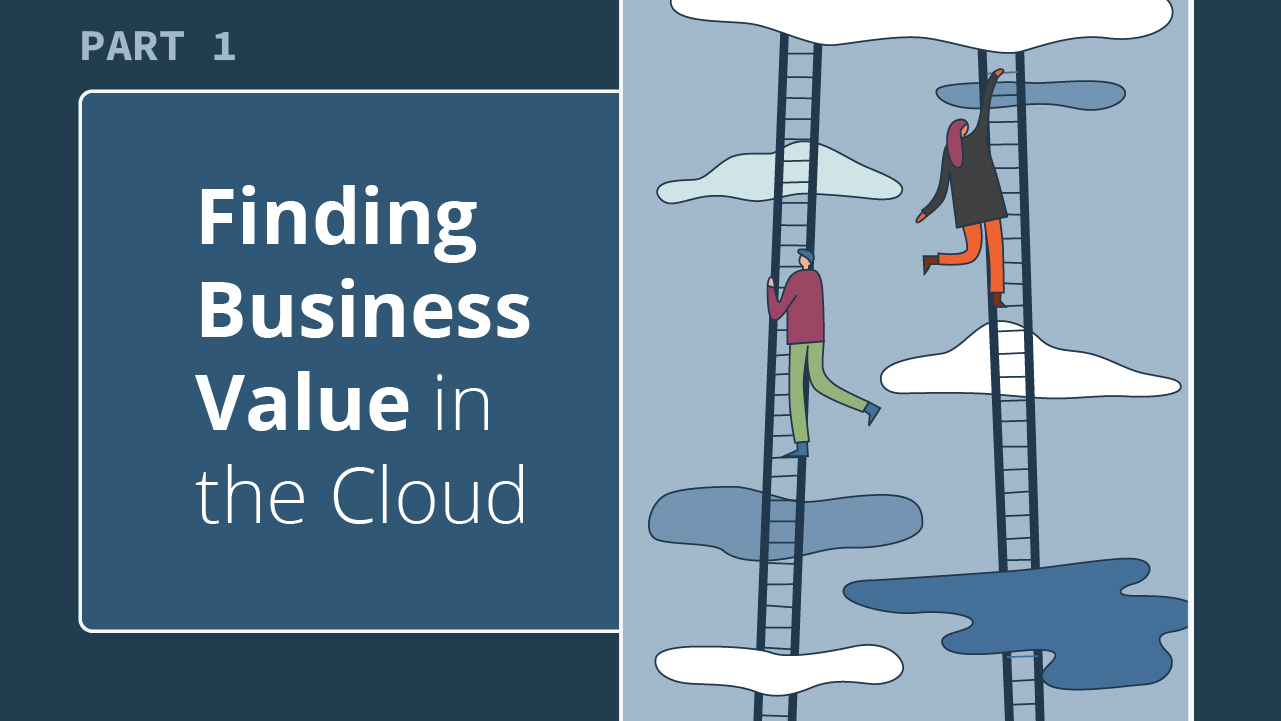Finding Business Value in the Cloud Part I: Challenges and Opportunities

About the author
This post was written by Merav Yuravlivker, Chief Executive Officer and co-founder at Data Society. Data Society specializes in providing industry-tailored data training programs and AI/ML solutions that enable Fortune 500 companies and government agencies to educate, equip, and empower their workforces. Since 2014, the company has trained thousands of professionals with the skills needed to solve complex challenges, realize new opportunities, and take their careers to the next level. Data Society was recognized as an Inc. 5000 2021 and 2022 fastest- growing company and named a top EdTech Company to watch by Forbes. For more information, visit www.DataSociety.com.
The business case for cloud adoption, far from lost on most companies today, continues to gain strength. At the root of the cloud’s growing appeal is its promise to drive increased speed, reliability, accessibility, and innovation. Still, many companies that need no further persuasion are held back by reasonable misgivings about making a bold move into unknown territory. Your organization might be among them.
In this blog, the first in a two-part series about shifting your operations to the cloud, we will dive into the questions you’ll face early in your journey. By the end of this series, you will gain a clearer sense of the possibilities for transforming your cloud aspirations into a cloud migration that aligns with your organization’s existing resources, core values, and visions for the future.
Understanding the Cloud’s Growing Appeal
Many organizations are already sold on the cloud’s merits as a worthy investment. In 2021, Gartner analysts estimated that, by 2025, 85 percent of organizations would adopt a cloud-first principle and over 95 percent of new digital workloads would be deployed on cloud-native platforms, compared to 30 percent in 2021. The momentum behind cloud computing makes sense given several benefits that it offers, including:
- Accelerated response and time to market.
- Savings on in-house IT infrastructure, support, and maintenance.
- Improved operational efficiencies.
- Increased innovation.
- Capabilities to implement digital strategies of the future.
To realize this potential value, your organization must begin with a defined cloud strategy that closely aligns IT goals with specific business use cases. This long-term vision, and the benchmarks marking progress toward achieving it, will take a different form for each organization. With this strategic roadmap in hand, your organization is ready to start evaluating the range of cloud options.
Facing an Expanding Field of Cloud Options
For companies giving serious thought to cloud adoption—or companies who are considering moving to a different provider—the decisions they must make along the way can be overwhelming, and the field of offerings continues to widen.
Cloud Services
As a first step, a thorough assessment of your company’s IT goals and budget will help you determine the cloud service, or combination of services, that best fits your teams’ unique needs. Whether you want to access applications in the cloud through Software-as-a-Service (SaaS), use cloud-hosted IT components through Infrastructure-as-a-Service (IaaS), or facilitate collaboration in a shared development environment through Platform-as-a-Service (PaaS), your selection of services will inform other decisions you will make on your journey to the cloud.
To navigate cloud service options, your organization should take stock of its current software and applications and understand how they interact with each other. Some issues to consider include which applications should be migrated, which should be retained in house, and which should be eliminated. If your legacy IT systems have enough useful life left in them, would it be more cost effective to continue using your current infrastructure and shift only platforms and software to the cloud?
Cloud Options
It is also important to determine which cloud deployment model, or combination of models, would be most appropriate for your organization’s purposes. While the basic cloud models are public and private, organizations are increasingly opting for hybrid deployments that combine public and private cloud or public cloud and on-premises IT resources. Multi-cloud models, which allow subscribers to take advantage of offerings from different cloud providers, are also increasingly popular and may be an ideal choice to ease concerns about vendor lock-in. Each of these models offers pros and cons related to flexibility, scalability, and security.
The public cloud accommodates shared, scalable workloads and options for pay-as-you-go services in a single environment. The public cloud’s leading providers, Amazon Web Services (AWS), Microsoft Azure, and Google Cloud Platform (GCP), command vast resources and sophisticated capabilities that enable them to offer tenants the advantage of scalability, affordability, and advanced security. These vendors also offer private cloud options through virtual private cloud (VPC) deployments. Determining the services and deployment models that will support the use cases you’ve defined for your company will help you navigate your options for providers.
Thinking Ahead to Challenges
The decisions you make about moving data and workloads to the cloud are not inconsequential, and there are many legitimate questions stakeholders across the organization might have that will need to be addressed before making this leap. Two common examples follow:
How can my organization control the costs associated with cloud usage?
While one of the most compelling reasons to consider cloud adoption is IT cost savings, uncertainty about expenses associated with the somewhat complex options for cloud services can be discouraging. This is understandable. According to Gartner, organizations that lack adequate cost optimization plans overspend by up to 70 percent on their cloud services.
However, as this statistic suggests, there are measures organizations can implement to prevent unexpected cloud expenses. FinOps offers an approach to cloud financial management that guides teams toward optimal capacity planning and resource provisioning. FinOps best practices can support informed decisions about the range of cloud options, such as pay-as-you-go serverless cloud and spot instances versus reserve instances or on-demand instances, guiding your organization toward the most cost-effective choices to meet different organizational needs. Companies can also control cloud costs by analyzing usage to determine if they are paying for resources they don’t need and to minimize waste, such as idling instances.
When calculating the cost of cloud adoption, it’s helpful to keep in mind that there are multiple layers of savings, expenditures, and revenue potential associated with this move. A review of the overall picture can help decision-makers get a better idea of the financial commitment at stake and advantages to be gained through cloud adoption. In making this assessment, take into account the potential long-term ROI of cloud adoption. For example, Coca-Cola saved 40 percent in operational costs due to its cloud migration. Many organizations also capture considerable value from the cloud through cloud-enabled innovation, which leads to a second common question.
How can the cloud power my organization’s data science initiatives?
Harnessing the cloud’s promise to support digital transformation and drive technological advancement, especially in data science, is a priority for many organizations seeking business value in the cloud. In fact, according to McKinsey, of the over $1 trillion estimated value that will be up for grabs for Fortune 500 companies leveraging cloud-enabled capabilities in 2030, the better part of this largesse will be attributable to innovation.
The cloud empowers data science teams with the computing might, scalability, speed, and resources they need to manage big data and train AI models. Data science teams can benefit from cloud platform offerings such as MLOps, DevOps, and DataOps. Other cloud tools include ML apps for speech recognition and recommendations, frameworks such as Keras, PyTorch, Jupyter Notebooks to develop and visualize models, and libraries of pre-trained ML algorithms.
Each of the top public cloud providers offers a range of tools to support machine learning projects, and Posit partners with AWS SageMaker, Azure Machine Learning, and Google Cloud Workstations (which recently announced its new partnership with Posit). An early example of a cloud adopter with a record for producing groundbreaking technologies, Capital One accelerated innovation through its cloud-based infrastructure.
Advancing Closer to the Cloud
Beyond potential cost savings and increased efficiency, we’ve seen how the cloud offers an environment where data science experimentation and innovation can flourish. Still, you will likely still have some valid concerns about challenges to navigate in the cloud. In the next part of this series, we’ll dive into some questions your organization might have about two other important considerations when moving into the cloud – security and sustainability.
